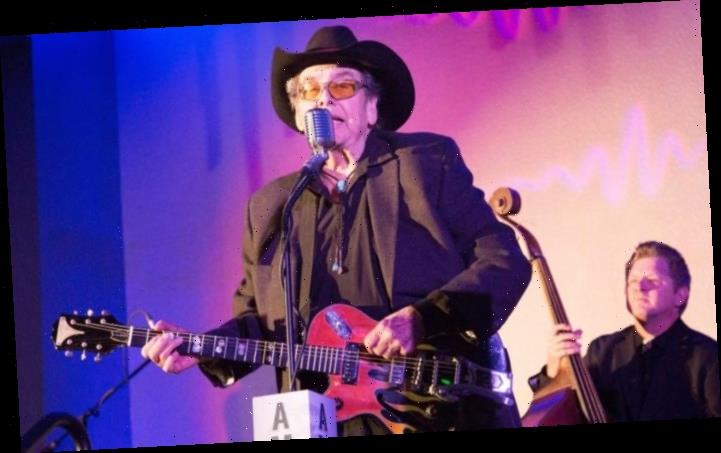Sleepy LaBeef, a rock and country performer who began his career in the mid-’50s and whose concerts continued to be a draw for the rockabilly community well into this year, died Thursday at age 84. No cause of death has been given.
Although LeBeef never had any singles chart above the 60s, his legend loomed almost as large as he did — the singer was around six-and-a-a-half feet tall — at festivals where he was often the lone remaining active link to the birth of rock ‘n’ roll. He earned his own chapter in one of the essential books about rock’s pioneers, Peter Guralnick’s “Lost Highway: Journeys and Arrivals of American Musicians.”
The death was confirmed by his family on his Facebook account. “It is with deep, agonizing sadness that we inform you of the news that this morning, Sleepy LaBeef, born Thomas Paulsley LaBeff, passed on from this life to be with the Lord,” wrote his wife, Linda LaBeef. “He died at home, in his own bed, surrounded by his family who loved him, and whom he dearly loved. He lived a full and vibrant life, filled with the excitement of much travel and experience, the contentment that came from being able to spend his life doing what he loved best, and the fulfilling love of his wife, children, and grandchildren around him.”
LaBeef was gigging at least as recently as September, when he performed at Switzerland’s Blues to Bop Festival, a sign of his enduring popularity among roots enthusiasts in Europe as well as America.
“Fare thee well to the only musician I ever witnessed play a three-hour medley,” wrote singer/songwriter Syd Straw on Facebook, referring to his legendarily wide repertoire.
The singer released singles on labels like Starday in the late ’50s, Columbia in the ’60s and the revived Sun imprint in the ’70s before finally catching fire with a new generation of rockabilly revivalists with a series of 1980s albums on Rounder. But nearly all his fans agreed that the live shows were really the thing — and there was no shortage of opportunities to catch him as he criss-crossed bar circuits across the country over the decades.
“I used to do about 300 shows a year,” he said in a 1991 New York Times profile. “Now I’ve cut it back to between 200 and 250, since I’m overseas so much.” As for his recordings, which generated only a few minor country chart successes, “I think you can listen to the records and tell that there’s a little bit lacking in enthusiasm,” he told Karen Schoemer.
Enthusiasm was not a problem for him on the road, where he was known to enthusiasts as “the human jukebox.” Saying he knew 6,000 songs — a claim that was credible to some of the pickup musicians who had to keep up with his ever-changing sets — LaBeef described his core sound to the Times as “root music: old-time rock-and-roll, Southern gospel and hand-clapping music, black blues, Hank Williams-style country. We mix it up real good.”
LeBeef was literally a towering figure in rockabilly, standing at 6’5″, 6’6″ or 6’7″, depending on which report you believed. He was also a hefty man, although health issues had led him to become uncharacteristically thin in recent years.
A documentary about him, “Sleepy LeBeef Rides Again,” was released in 2013. That film’s director, Dave Pomeroy, has created a page to raise money for his funeral expenses.
“He was a great entertainer, a roots music encyclopedia and a man of God,” Pomeroy wrote. “He was one of a kind, and despite never getting the recognition he deserved, he was always humble and never bitter. I am in shock but I am grateful for having known him.”
LaBeef was born in Smackover, Arkansas, and got his nickname as the result of a lazy eye. He moved to Houston in his adolescence and became a regular on radio shows like the Louisiana Hayride.
Deke Dickerson, one of the leading modern musicians in the genre, wrote on Facebook: “Sleepy was one of the original ’50s rockabillies. He made excellent records for Starday, Mercury, Dixie and Wayside. In a way he was one of the first ’50’s revivalists,’ cutting greasy rock and roll records all through the British Invasion years of the mid-’60s, but the truth was that Sleepy existed in a Gulf Coast world of rough bars and sleazy dives where the hard driving ’50s rock and roll mixed with classic country never went away. Sleepy was HUGE. I always referred to him as a ‘Man-Mountain,’ and I always found it comical when I loaned him a guitar or upright bass and it looked like a ukulele or a toothpick on his large frame. His girth enabled him to portray ‘The Swamp Thing’ (a large, semi-naked caveman/wildman character) in the 1968 exploitation film ‘The Exotic Ones,’ a memorable film moment, if you’ve ever had the good fortune to screen that particular gem.”
Added Dickerson, “He became known as ‘The Human Jukebox’ because he seemed to know every song ever written, and sometimes his shows would consist of him performing for three or four hours straight, no breaks, with short-and-long term band members holding on for dear life, often not knowing the songs as Sleepy plowed through them like a mule plowing through hard and rocky Arkansas farmland.”
Dickerson relayed an amusing story about how, at one overseas festival appearance, a new band had to be assembled for LaBeef on the spot. The local musicians he had planned to use found themselves unsuited to the task — it seemed they had thoroughly learned and rehearsed his recorded repertoire, but didn’t realize they’d need to know the entire “Great American Songbook” from which he freely drew his sets.
Source: Read Full Article
